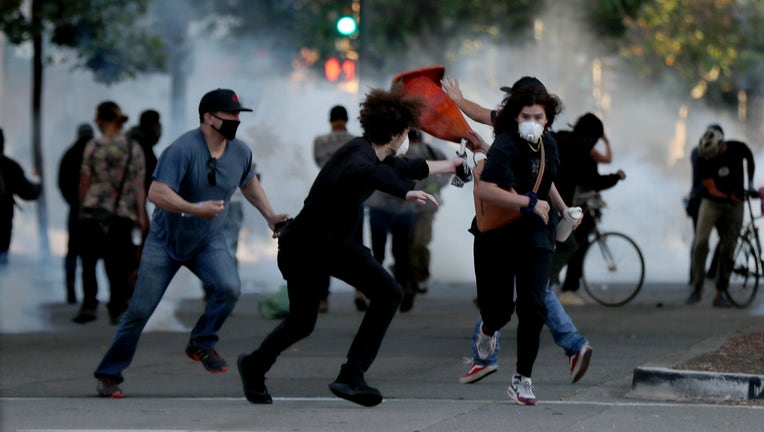Judge orders preliminary injunction against Oakland police over crowd control policy

OAKLAND, CA - JUNE 1: Protesters run away as police shoot tear gas and flash grenades to disperse the crowd on Broadway near the Oakland Police Department during the fourth day of protests over George Floyd's death by the Minneapolis police in Oaklan
OAKLAND, Calif. - In a positive step for an activist group seeking to ban chemical weapons forever from Oakland, a federal magistrate on Wednesday extended his previous restrictions for Oakland police, forbidding the department from using tear gas or flash-bang grenades against demonstrators, except when necessary to prevent serious injury or substantial property damage.
Chief U.S. Magistrate Joseph Spero also barred all use of wooden or rubber bullets and pepper-ball projectiles in his ruling, in an injuction that will remain in effect indefinitely.
"This Order provides that certain crowd control tactics and munitions shall not be used except in very limited circumstances. This Order should not be read as permission to use these tactics and munitions," Spero wrote.
"We consider this a victory," said civil rights attorney Walter Riley, who along with Dan Siegl, is representing the plaintiffs including the Anti Police-Terror Project. "It's a strong start to our expected ban on chemical weapons."
He ruled that chemical agents -- including tear gas -- flash-bang grenades and other projectiles can only be deployed when there is an imminent threat of physical harm to a person, a significant destruction of property, and only when other techniques such as arrests or police formations have failed. The judge further ruled that these items cannot be indiscriminately launched into a crowd.
Even so, the judge's ruling states certain use of force, depending on the circumstance, may be unlawful based on existing precedent.
When dispersing a crowd, the judge requires OPD to make two announcements and to identify two means of escape and to allow the demonstrators time to exit the area.
These rules had already been established in Oakland as part of a court order negotiated after the early 2003 Occupy protests.
Last month, the same judge issued a temporary restraining order against OPD that limited their use of tear gas and rubber bullets during protests as a crowd-control measure.
Wednesday's order goes further by requiring police to make their badges and nameplates visible on their uniform or helmets during protests. In addition, police deployed to demonstrations and protests must have their body-worn cameras on and recording at all times. Police vehicles cannot be used to disperse crowds and are limited to traffic control, observation and transportation.
Any law enforcement agencies brought in as mutual aid in these situations are subject to OPD policies and must be briefed on them beforehand. Any assisting departments are not allowed to be on the frontlines and they cannot bring weapons prohibited under the judge's orders for OPD.
In addition, the judge has ordered OPD incident, operations commanders and others to undergo special training by Nov. 1.
Oakland police told the Chronicle they would adhere to the judge's order.

